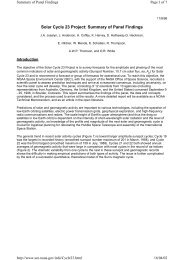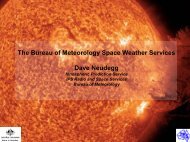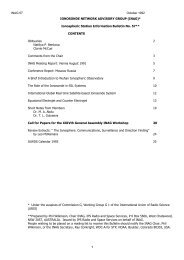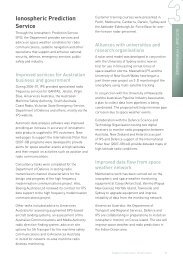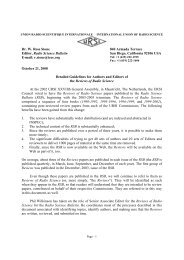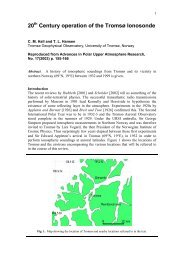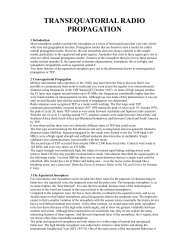UAG-93: Chapters 1 to 5 - URSI
UAG-93: Chapters 1 to 5 - URSI
UAG-93: Chapters 1 to 5 - URSI
Create successful ePaper yourself
Turn your PDF publications into a flip-book with our unique Google optimized e-Paper software.
3. SELECTIoT{ 0F AN t{( h)<br />
!,|ETHOD<br />
Choice of an appropriate method of N(h) analysis depends on the amount and accuracy of the<br />
desired profile informatjon. This in turn is djctated by the application. Three main groups,<br />
requiring different levels of accuracy, may be distinguished and are discussed jn 3.1 <strong>to</strong> 3.3 below.<br />
A fourth area is the au<strong>to</strong>mated analysis of digital ionograms. This requires additional program checks<br />
for poor or nonsensical data, <strong>to</strong> prevent premature program termination, and methods for dealing<br />
correctly with Sporadic E reflections. A modified subroutine DP0LAN has been developed for this<br />
purpose and is available (with l ittle documentation) from the author.<br />
3.1 Rapid Estimation of Layer Constants<br />
Some studies require only first-order estimates of the height and thickness of the ionospheric<br />
layers. These would include the examination of large-scale variations, or the correction of other<br />
measurements (such as <strong>to</strong>tal electron content and transionospheric U.H.F. propagation) for the<br />
approximateffects of the sub-peak ionospnere. The rapid single-polynomial analysis was designed<br />
specifically for such purposes. 0nly 5 or 6 virtual heights need be scaled, at frequencies defined<br />
by a grid on<strong>to</strong> which the ionogram is projected. The measurements may be processed on a programmable<br />
calcula<strong>to</strong>r using publ ished coefficients (Titheridge, 1969), or with a simple computer program and<br />
coefficients caiculated (or obtained from the author) for a particular site. Results give directly<br />
the peak height of the layer, the scale height at the peak, the sub-peak electron content, and the<br />
approximate real heights at the scaled frequencies.<br />
The method and the scaling frequencies are designed for maximum accuracy, with minimum effort,<br />
near the peak of a layer. in thjs region results approach those from a normal mono<strong>to</strong>nic lamination<br />
analysis. Real heights are not accurate near the peak of an underlying layer, particularly when there<br />
is an appreciable valley between the two layers. This is an inevitable result of the smoothed<br />
representation used at lower frequencies. Thus when realistic profile shapes are required across<br />
underlying peaks on cusp regions the single-polynomial anaiysis should not be used.<br />
The accuracy of the single-polynomial analysis has been investigated by l'lcNamara (1976), by<br />
comparing the reiults with tiue profiles including (for the daytime F layer) an underlying E-F valley.<br />
Results should more appropriately be compared with the equivalent mono<strong>to</strong>nic profi'le, since this is<br />
what the method is attempting <strong>to</strong> emulate. The larger errors obtained near the valley region are then<br />
removed. Correctly used the single-polynomial analysis gives good est.imates of the main<br />
characteristjcs of the ionospheric layers, and saves a great deal of time when more detailed profile<br />
jnformation is not required.<br />
3.2 Calculation of l,lono<strong>to</strong>nic Profiles<br />
Many studies require some knowledge of the variation of electron density with height below the<br />
peaks of the layers, but are satisfied with a mono<strong>to</strong>nic representation. This category has, perforce,<br />
included most stud.ies <strong>to</strong> date, since few current procedures will consistently allow for 1ow-density or<br />
va11ey ionisation. Neglect of the low-density (underlying) ionlsation.is most serious at ni9ht, when<br />
only the F layer is observed. Results are then typically 5 <strong>to</strong> 50 km <strong>to</strong>o high at the lowest<br />
frequencies, and I <strong>to</strong> 10 km <strong>to</strong>o high at the layer peak. Neglect of the va11ey between the daytime E<br />
and F layers gives calculated heights which are commonly l0 <strong>to</strong> 50 km <strong>to</strong>o low at frequencies above<br />
foE, and about 5 km <strong>to</strong>o low near the peak of the F layer. The errors due <strong>to</strong> these unobser^ved regions<br />
vary smoothly with frequency; at frequencies^more than i MHz above fmin (night) or foE (Oay) the<br />
real-height errors vary approximately as I/ft.<br />
Reasonably accurate mono<strong>to</strong>nic profiles require virtual-height data at frequency intervals of<br />
about 0.i <strong>to</strong> 0.5 MHz. The smaller intervals are used near foE, and possibly near foFl and foF2. The<br />
<strong>to</strong>tal number of points scaled is commonly between 15 (at night) and 50 (for day-time ionograms with<br />
several cusps) when a polynomial analysis is used. The linear lamination method needs considerably<br />
smal'ler frequency intervals <strong>to</strong> avoid systematic errors in regions of large profile curvature. Severa'l<br />
alternative procedures are available which reduce this curvature error by a fac<strong>to</strong>r of 20 <strong>to</strong> 100, with<br />
little increase in computing time or complexity. A good example is the parabolic laminatjon analysis<br />
described by Paul (1977). The linear offset procedure (Titheridge, I979) gives similar results with a<br />
very compact program.<br />
Use of the overlapping-polynomial program LAP0L (Section 2.3) can reduce costs appreciably.<br />
The abil ity <strong>to</strong> change profile curvature between scaled frequencies gives greater accuracy, and makes<br />
the cho.ice of scaling frequencies less important. V.irtual heights may therefore be scaled at fixed<br />
frequencies, and anaiysed with precalculated coefficients (Titheridge' 1967b, I974a). This gives an<br />
extremely fast analysis (one second per ionogram, on a minicomputer) at the cost of a somewhat larger<br />
11




